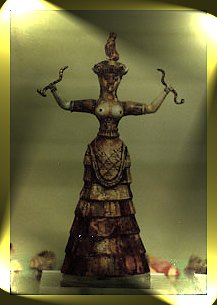The White Moon Gallery Presents
The Minoan Goddess

Created by Morgana Ravenwings
© All
original material in this site is under copyright protection and is the
intellectual property of the author.
The White Moon Gallery Presents
The Minoan Goddess

Created by Morgana Ravenwings
© All
original material in this site is under copyright protection and is the
intellectual property of the author.
Arthur Evans associated Her with Wazet of Egypt. In Lower Egypt, snake-wands were used by priests conducting magic and it is believed that they symbolized this Goddess. Evans drew this link with Wazet because Egyptian artifacts were found in Minoan Crete. One of them was the lower half of a human male identified by hieroglyphics as a priest of Wazet. He theorized that the Minoan Goddess was holding snake-wands as opposed to real snakes.
She was also known as Goddess of the Sacred Tree and there are depictions of Her nursing an infant, similar to Isis and Horus. In one depiction, She is shown as a mother with a maiden sitting at Her feet and accompanied by a young boy. This is called a "kourotropis" and may be one of the earliest depictions of what today is known as the 'trinity'. There are images similar to this in Catal Huyek. Call on this Goddess when you have need of anything. She is the great All-Mother who looks after all of us as a mother cares for her children. She has been waiting patiently for us to remember the things She one taught us, to re-create Her rituals, and to give Her the honor She is due.
Preparation: Ritual bath Prepare your bath, adding the hyssop wrapped in cheesecloth. The hyssop will give you a tingly feeling as you soak in it. Imagine all negativity leaving you, being washed away. Now imagine that each pore in your body is opening and being infused with the essence of the Divine. As you let the water drain away, imagine all the negativity going down the drain with it and flowing out to the ocean. Once it reaches the ocean, it is absorbed and neutralized by the Great Goddess. It is gone, no longer exerting any influence over you. Set up your altar, facing the west. Light your candles and charcoal block. When the block is ready, throw some of the Dittany of Crete on it. Outline your circle area with the sea water. Cast your circle, beginning in the west. Now, once again beginning in the west, call on the element of water to join you in your rite. Imagine a dolphin coming to you. Move to the north and call on the element of earth to join you in your rite. Imagine a bull coming and joining you, sitting right inside the circle. Move to the east, and call on the element of air to join you. Imagine a white dove alighting right inside the eastern point of the circle. Now move to the south and call on the element of fire to join you in this rite. See a lion in all her majesty sauntering up to the circle and moving inside and sitting. Come back to the west, and with feet spread apart and arms upraised, recite the following prayer:
Take a little of the sea water and annoint your forehead in the symbol of a crescent moon and say "Bless me
Mother, for I am your
Daughter."
Sit down in front of your altar and begin to meditate on the peace that this Goddess instilled in Her followers.
Now pick up your tamborine or sistrum and begin tapping it, gently at first and getting more and more joyous with it as the power begins flowing through you. Begin to dance. Allow the energy to flow through you and be expressed in the form of dance. Dance is sacred to this Goddess, so allow Her to guide your feet and your movements. Feel Her power with your entire being, pulsing. Become one with it. Make it your own. When you are done, fall to the ground, palms down on the earth and allow the excess energy to flow through you into the earth. Arise, thank the Goddess for all She has given you this day. Thank the elementals for joining you. Open your circle. Leave your violets or poppies on the shore at the ocean for the waves to receive as an offering. If you are not near the ocean, any body of living water will do. Finally, this Goddess is very powerful, so expect wondrous things to begin occurring in your life after performing this ritual. Blessed Be! Bibliography 1. Gadon, Elinor W. The Once and Future Goddess. New York: HarperCollins Publishers, 1989. 2. Trckova-Flamee, Alena Britomartis. http://www.pantheon.org/articles/b/britomartis.html 3. Trckova-Flamee, Alena Minoan Snake Goddess. http://www.pantheon.org/articles/m/minoan_snake_goddess.html 4. The Mythic Images Collection: Cretan Snake Goddess. http://www.mythicimages.com/printsnake.htm 5. Hooker, Richard. Bureaucrats & Barbarians: The Minoans: Minoan Religion . http://www.wsu.edu:8080/~dee/MINOA/RELIGION.HTM 6. Witcombe, Christopher L.C.E. Women in the Aegean: Minoan Snake Goddess. http://witcombe.sbc.edu/snakegoddess/minoanculture.html 7. Britomartis. http://www.theoi.com/Kronos/Britomartis.html |